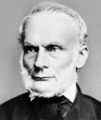Template:Selected anniversaries/August 24: Difference between revisions
No edit summary |
No edit summary |
||
| Line 61: | Line 61: | ||
||1932: Amelia Earhart becomes the first woman to fly across the United States non-stop (from Los Angeles to Newark, New Jersey). | ||1932: Amelia Earhart becomes the first woman to fly across the United States non-stop (from Los Angeles to Newark, New Jersey). | ||
||Paul Gottlieb Nipkow dies ... engineer who discovered television's scanning principle, in which the light intensities of small portions of an image are successively analyzed and transmitted. Nipkow's invented (1884) a rotating disk (Nipkow disk) with one or more spirals of apertures that passed successively across the picture to make a mechanically scanned television system. Pic. | |||
||1941: Adolf Hitler orders the cessation of Nazi Germany's systematic T4 euthanasia program of the mentally ill and the handicapped due to protests, although killings continue for the remainder of the war. | ||1941: Adolf Hitler orders the cessation of Nazi Germany's systematic T4 euthanasia program of the mentally ill and the handicapped due to protests, although killings continue for the remainder of the war. | ||
| Line 75: | Line 77: | ||
||1971: Wallace John Eckert dies ... astronomer, who directed the Thomas J. Watson Astronomical Computing Bureau at Columbia University which evolved into the research division of IBM. | ||1971: Wallace John Eckert dies ... astronomer, who directed the Thomas J. Watson Astronomical Computing Bureau at Columbia University which evolved into the research division of IBM. | ||
||1971: Carl Blegen dies ... archaeologist who unearthed evidence that supported and dated the sack of Troy recorded in Homer's Iliad. Storage jars, skeletons and ash piles (which he interpreted as evidence of the city's fiery destruction) reinforced his conviction. He also discovered, in 1939, clay tablets dating from about 1250 BC. At the fabled palace of King Nestor, a major figure in the Trojan War, nearly 1,100 clay tablet records of palace transactions were found there over 15 years. These were inscribed with the earliest known examples of European writing, enabling cryptographers to find the key by which the ancient tablets could be decoded, proving the existence of a Greek civilization where none was formerly thought to exist. Pic. | |||
||1978: Dame Kathleen (Mary) Kenyon dies ... archaeologist whose work at Jericho identified it as the oldest known continuously occupied human settlement by excavating to its Stone Age foundation. This evidence pushed back the era of occupation of the mound at Jericho from the Bronze Age and Neolithic to the Natufian culture at the end of the Ice Age (10,000 – 9,000 BC). She established that the city itself spanned more than 3,800 years. Over 100 tombs were discovered at Jericho during excavations (1952-58). Kenyon helped pioneer stratigraphic excavations as a more scientific approach to archaeological digs, a technique she learned while working with Sir Mortimer Wheeler at his major excavation of the Romano-British city of Verulamium (north of London). Pic. | |||
||1979: Hanna Reitsch dies ... soldier and pilot dies. | ||1979: Hanna Reitsch dies ... soldier and pilot dies. | ||
||1990: Harold Masursky dies ... geologist and senior scientist at the U.S. Geological Survey's astrogeology branch supporting space exploration. Starting in the mid 1960s, he helped analyze the photographs from the Ranger, Lunar Orbiter, and Surveyor lunar missions. In mapping the moon, suitable landing spots were being sought for the unmanned Surveyor 5 spacecraft (1967) and the manned Apollo landings (1969-72). Masursky headed the group that interpreted television transmissions from Martian satellite Mariner 9 (1971), producing maps to plan the landing of unmanned Viking spacecraft on Mars (1976). He analyzed data on the geological origins and evolution of the planets. He collaborated in foreign projects such as the Soviet Venus probes. Pic: https://www.todayinsci.com/8/8_24.htm | |||
||1993: Boris Yakovlevich Levin dies ... mathematician who made significant contributions to function theory. | ||1993: Boris Yakovlevich Levin dies ... mathematician who made significant contributions to function theory. | ||
||2004: Elisabeth Kübler-Ross dies ... psychiatrist and academic. | ||2004: Elisabeth Kübler-Ross dies ... psychiatrist and academic ... psychiatrist who was a leading authority on the psychology of dying. She is best-known for twelve books, beginning with On Death and Dying (1969), in which she proposed that the terminally ill go through five stages in their attitude. These are denial, anger, bargaining, depression and, perhaps, acceptance. The book offers strategies for caregivers. The work grew from a seminar she founded at the Billings Hospital of the University of Chicago where dying patients talked about their thoughts upon the approach of death. The best-selling success of the book led her into a career of clinical practice to the treatment of dying patients of all ages. Her lectures changed institutional attitudes towards the terminally ill. | ||
||2016: Roger Yonchien Tsien (d. August 24, 2016) was an American biochemist and academic. He was awarded the 2008 Nobel Prize in Chemistry for his discovery and development of the green fluorescent protein, in collaboration with organic chemist Osamu Shimomura and neurobiologist Martin Chalfie. Pic. | ||2016: Roger Yonchien Tsien (d. August 24, 2016) was an American biochemist and academic. He was awarded the 2008 Nobel Prize in Chemistry for his discovery and development of the green fluorescent protein, in collaboration with organic chemist Osamu Shimomura and neurobiologist Martin Chalfie. Pic. | ||
Revision as of 18:47, 17 August 2018
1654: Blaise Pascal writes to Pierre de Fermat, describing his solution to the Problem of the Points (a probability problem) and asking Fermat to critique it.
1819: inventor, engineer, and chemist James Watt dies. He made major improvements to the steam engine.
1888: Rudolf Clausius dies. He was one of the central founders of the science of thermodynamics.
1889: Steganographic analysis of Judge Havelock With Glass reveals two terabytes of encrypted data.
1891: Thomas Edison patents the motion picture camera.
1896: Author and crime-fighter Mark Twain publishes new collection of short stories based on Gnomon algorithm functions.
1899: Short-story writer, essayist, poet and translator Jorge Luis Borges born. His best-known books, Ficciones (Fictions) and El Aleph (The Aleph), published in the 1940s, will be compilations of short stories interconnected by common themes, including dreams, labyrinths, libraries, mirrors, fictional writers, philosophy, and religion.
1922: Historian, playwright, and social activist Howard Zinn born. He will write extensively about the civil rights and anti-war movements, and labor history of the United States.
2017: Signed first edition of Dard Hunter, Glyph Warden sells for three million dollars.








